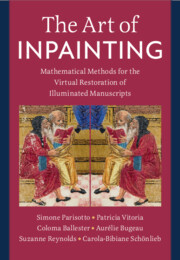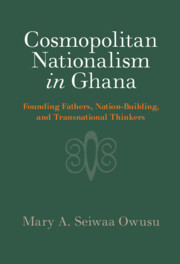Refine search
Actions for selected content:
198 results
Conclusion: Reflections, Ideas, Supplements
- from Part IV - Scholarship
-
-
- Book:
- The Cambridge Companion to <i>The Rite of Spring</i>
- Published online:
- 28 June 2025
- Print publication:
- 17 July 2025, pp 285-298
-
- Chapter
- Export citation
Chapter 8 - Entropy and synthesis
-
- Book:
- The Pattern of Change
- Published online:
- 17 June 2025
- Print publication:
- 03 July 2025, pp 212-269
-
- Chapter
- Export citation
The relation between head movement and periphrasis
-
- Journal:
- Journal of Linguistics , First View
- Published online by Cambridge University Press:
- 23 June 2025, pp. 1-28
-
- Article
-
- You have access
- Open access
- HTML
- Export citation

The Art of Inpainting
- Mathematical Methods for the Virtual Restoration of Illuminated Manuscripts
-
- Published online:
- 22 May 2025
- Print publication:
- 22 May 2025
3 - Non-Local Inpainting Methods
-
- Book:
- The Art of Inpainting
- Published online:
- 22 May 2025
- Print publication:
- 22 May 2025, pp 52-114
-
- Chapter
- Export citation
Afterword
-
-
- Book:
- Coups d'État in Cold War Latin America, 1964–1982
- Published online:
- 24 April 2025
- Print publication:
- 08 May 2025, pp 215-232
-
- Chapter
- Export citation
Chapter 39 - “I Wish I Could Be Like a Tree”
-
-
- Book:
- Pillars of Developmental Psychology
- Published online:
- 14 February 2025
- Print publication:
- 20 February 2025, pp 445-457
-
- Chapter
- Export citation
Chapter 6 - Studying Children in Sociocultural Context: A Widening Journey
-
-
- Book:
- Pillars of Developmental Psychology
- Published online:
- 14 February 2025
- Print publication:
- 20 February 2025, pp 55-67
-
- Chapter
- Export citation
3 - Rethinking Cultural Nationalism as Debates on Synthesis (1887–1920)
-
- Book:
- Cosmopolitan Nationalism in Ghana
- Published online:
- 12 December 2024
- Print publication:
- 19 December 2024, pp 100-157
-
- Chapter
- Export citation

Cosmopolitan Nationalism in Ghana
- Founding Fathers, Nation-Building, and Transnational Thinkers
-
- Published online:
- 12 December 2024
- Print publication:
- 19 December 2024
Kinetics of Mg-Ni saponite crystallization from precursor mixtures
-
- Journal:
- Clays and Clay Minerals / Volume 72 / 2024
- Published online by Cambridge University Press:
- 14 October 2024, e16
-
- Article
- Export citation
The Influence of Aluminum on Iron Oxides. VII. Substitution of Al for Fe in Synthetic Lepidocrocite
-
- Journal:
- Clays and Clay Minerals / Volume 28 / Issue 4 / August 1980
- Published online by Cambridge University Press:
- 01 July 2024, pp. 267-271
-
- Article
- Export citation
Syntheses of Glauconite at Surface Temperatures
-
- Journal:
- Clays and Clay Minerals / Volume 28 / Issue 3 / June 1980
- Published online by Cambridge University Press:
- 01 July 2024, pp. 217-222
-
- Article
- Export citation
Hydrothermal Formation of a Kaolinite-Like Product from Noncrystalline Aluminosilicate Gels
-
- Journal:
- Clays and Clay Minerals / Volume 29 / Issue 6 / December 1981
- Published online by Cambridge University Press:
- 01 July 2024, pp. 446-450
-
- Article
- Export citation
Crystal Chemistry of Boehmite
-
- Journal:
- Clays and Clay Minerals / Volume 28 / Issue 5 / October 1980
- Published online by Cambridge University Press:
- 01 July 2024, pp. 373-380
-
- Article
- Export citation
Physico-Chemical Properties of Synthetic Hydrotalcites in Relation to Composition
-
- Journal:
- Clays and Clay Minerals / Volume 28 / Issue 1 / February 1980
- Published online by Cambridge University Press:
- 01 July 2024, pp. 50-56
-
- Article
- Export citation
Kaolinite Synthesis. I. Crystallization Conditions at Low Temperatures and Calculation of Thermodynamic Equilibria. Application to Laboratory and Field Observations
-
- Journal:
- Clays and Clay Minerals / Volume 26 / Issue 6 / December 1978
- Published online by Cambridge University Press:
- 01 July 2024, pp. 397-408
-
- Article
- Export citation
The Crystal Structure of Boehmite
-
- Journal:
- Clays and Clay Minerals / Volume 27 / Issue 2 / April 1979
- Published online by Cambridge University Press:
- 01 July 2024, pp. 81-86
-
- Article
- Export citation
Synthesis of Iron Layer Silicate Minerals under Natural Conditions
-
- Journal:
- Clays and Clay Minerals / Volume 26 / Issue 1 / February 1978
- Published online by Cambridge University Press:
- 01 July 2024, pp. 65-72
-
- Article
- Export citation
Synthesis and Properties of Poorly Crystalline Hydrated Aluminous Goethites
-
- Journal:
- Clays and Clay Minerals / Volume 29 / Issue 2 / April 1981
- Published online by Cambridge University Press:
- 01 July 2024, pp. 91-100
-
- Article
- Export citation
